9288 A MOST UNUSUAL BOXWOOD LIBRARY TABLE IN THE MANNER OF ANDREA BRUSTOLON Probably English. Circa 1820. Measurements: Height: 31 1/4″ (79 1/2cm) Width: 55″ (140cm) Depth: 43 1/4″ (110cm)
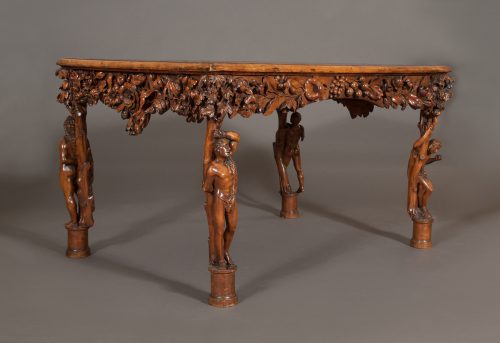
Research
Of boxwood. The rectangular top with original tooled Morocco leather inset and a molded edge, the top above the apron profusely carved to all four sides with fruit and foliage, the whole raised on four legs, each carved as a classical figure resting on a tree trunk, each figure raised on a round plinth, each leg terminating in a hooved foot.
This highly unusual table is conceived in the distinctive manner of the renowned seventeenth-century Venetian sculptor and furniture maker Andrea Brustolon (1662 – 1732).
Brustolon trained under the celebrated Genoese carver and sculptor Filippo Parodi, from whom he gained the expertise needed to carve the exquisitely detailed, fantastical furniture which adorned the great Venetian palazzi at the end of the seventeenth century. Always striving for ‘the grand effect’ over the mundane requirements of utility, his work came to epitomise this highly sophisticated and opulent style.
Brustolon’s best known commission, for the great Venetian patriarch Pietro Venier, now in the Ca’ Rezzonico Museum, Venice, is more akin to sculpture than furniture.1 The pieces, which include armchairs with tree-like arms supported by carved figures, a signed side table and vase stand supported by a carved figure of Hercules (figure 1), and a series of elaborate stands, are all conceived in the distinctive theatrical and naturalistic manner that inspired the present table.
The form of the table is highly inventive, with four full length figures forming the legs, each individually designed. They represent Prometheus chained at the wrists, Cinyras, the father of Adonis, who split open a myrrh tree from which emerged his new born son, and Mercury, who is depicted here as a beardless youth carrying a purse, his badge as one of the Roman gods of commerce. Hercules, one of Brustolon’s favorite characters is also shown, bearing a club and a lion’s skin. It is a pleasing design feature that one side of the carved frieze is subtly arched to accommodate the sitter, while the foliate carved decoration on side facing the room is allowed greater profusion.
Like those depicted on the Ca’ Rezzonico vase stand, the figures on the table avoid the stiffness of traditional classical poses and have been executed with a romantic sensibility. Almost hermit-like in appearance, their bodies are positioned in sympathy with the wild foliage, emphasising the drama of the grottoesque carving.
As well as representing a skilled interpretation of Brustolon’s style, the table also shares with Brustolon’s work the highly unusual feature of being carved in boxwood. The slow growth and highly dense nature of boxwood meant it was difficult to work with on this scale and as a result its use in furniture was largely restricted to marquetry designs and other inlaid details. It is extremely rare to find a piece of furniture made wholly from boxwood, and the Brustolon pieces at the Ca’ Rezzonico are among the very few examples in existence.2
Brustolon’s rich style, with its emphasis on nature, was highly prized among a select group of early nineteenth-century antiquarian connoisseurs, and it is within this spirit that the present table was undoubtedly created. Valuing the romantic and imaginative associations of an antiquarian aesthetic which provided an alternative to the increasingly staid classicism of the time, men such as the novelist Walter Scott and the poet Lord Byron became avid collectors of objects artifacts from the middle ages and sixteenth and seventeenth centuries.
Scott is known to have acquired two chairs attributed to Brustolon for the library in his country house, Abbotsford, in 1822. Built and furnished to his specifications in what was to become a model for the ‘Baronial’ taste, the fame of Abbotsford’s antiquarian style attracted visitors such as Wordsworth and Turner.3 The chairs were a gift from Scott’s publisher, Archibald Constable, purchased from a Mr. Swaby of Wardour Street. Swaby informed him they were of a set of ten chairs imported from Rome by the Abbé Celotti. Six were purchased by the Duke of Rutland for Belvoir Castle, two by Byron for his ancestral home at Newstead, the remaining pair going to Abbotsford.4 The distinctive style shared by the chairs and the present table was thought to be highly appropriate for these romantic interiors and it is for such a scheme that the present table would almost certainly have been commissioned.
Footnotes:
1 H. Honour, Cabinet Makers and Furniture Designers, New York, G.P Putnam’s Sons, 1969, p. 64, 66.
2 F.L. Hinckley, Directory of the Historic Cabinet Woods, New York, Crown Publishers Inc, 1960, p. 45.
3 C. Wainwright, The Romantic Interior, London, Yale University Press, 1989, p. 148.
4 C. Wainwright, The Romantic Interior, London, Yale University Press, 1989, p. 193.
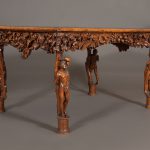
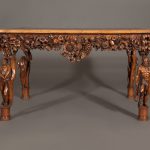
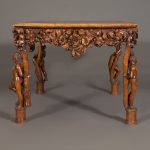

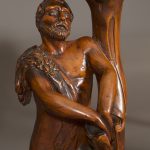
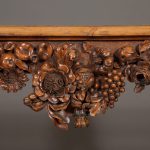

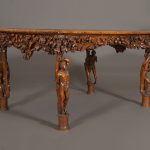
Comments are closed.